2018 Hyundai Elantra belt
[x] Cancel search: beltPage 461 of 526

7-43
7
Maintenance
Tire Terminology and
Definitions
Air Pressure
The amount of air inside the tire
pressing outward on the tire. Air
pressure is expressed in pounds per
square inch (psi) or kilopascal (kPa).
Accessory Weight
This means the combined weight of
optional accessories. Some exam-
ples of optional accessories are
automatic transmission, power
seats, and air conditioning.
Aspect Ratio
The relationship of a tire's height to
its width.
Belt
A rubber coated layer of cords that is
located between the plies and the
tread. Cords may be made from steel
or other reinforcing materials.
Bead
The tire bead contains steel wires
wrapped by steel cords that hold the
tire onto the rim.
Bias Ply Tire
A pneumatic tire in which the plies
are laid at alternate angles less than
90 degrees to the centerline of the
tread.
Cold Tire Pressure
The amount of air pressure in a tire,
measured in pounds per square inch
(psi) or kilopascals (kPa) before a tire
has built up heat from driving.
Curb Weight
This means the weight of a motor
vehicle with standard and optional
equipment including the maximum
capacity of fuel, oil and coolant, but
without passengers and cargo.
DOT Markings
A code molded into the sidewall of a
tire signifying that the tire is in com-
pliance with the U.S. Department of
Transportation motor vehicle safety
standards. The DOT code includes
the Tire Identification Number (TIN),
an alphanumeric designator which
can also identify the tire manufactur-
er, production plant, brand and date
of production.
GVWR
Gross Vehicle Weight Rating
GAWR FRT
Gross Axle Weight Rating for the
Front Axle.
GAWR RR
Gross Axle Weight Rating for the
Rear axle.
Intended Outboard Sidewall
The side of an asymmetrical tire, that
must always face outward when
mounted on a vehicle.
Page 464 of 526

7-46
Maintenance
All Season Tires
HYUNDAI specifies all season tires
on some models to provide good
performance for use all year round,
including snowy and icy road condi-
tions. All season tires are identified
by ALL SEASON and/or M+S (Mud
and Snow) on the tire sidewall. Snow
tires have better snow traction than
all season tires and may be more
appropriate in some areas.
Summer Tires
HYUNDAI specifies summer tires on
some models to provide superior
performance on dry roads. Summer
tire performance is substantially
reduced in snow and ice. Summer
tires do not have the tire traction rat-
ing M+S (Mud and Snow) on the tire
side wall. If you plan to operate your
vehicle in snowy or icy conditions,
HYUNDAI recommends the use of
snow tires or all season tires on all
four wheels.
Snow Tires
If you equip your car with snow tires,
they should be the same size and
have the same load capacity as the
original tires. Snow tires should be
installed on all four wheels; other-
wise, poor handling may result. Snow
tires should carry 4 psi (28 kPa)
more air pressure than the pressure
recommended for the standard tires
on the tire label on the driver’s side of
the center pillar, or up to the maxi-
mum pressure shown on the tire
sidewall, whichever is less. Do not
drive faster than 75 mph (120 km/h)
when your vehicle is equipped with
snow tires.
Radial-Ply Tires
Radial-ply tires provide improved
tread life, road hazard resistance and
smoother high speed ride. The radi-
al-ply tires used on this vehicle are of
belted construction, and are selected
to complement the ride and handling
characteristics of your vehicle.Radial-ply tires have the same load
carrying capacity, as bias-ply or bias
belted tires of the same size, and use
the same recommended inflation
pressure. Mixing of radial-ply tires
with bias-ply or bias belted tires is
not recommended. Any combina-
tions of radial-ply and bias-ply or bias
belted tires when used on the same
vehicle will seriously deteriorate
vehicle handling. The best rule to fol-
low is: Identical pairs of radial-ply
tires should always be used as a set
for the front tires and a set for the
rear tires.
Longer wearing tires can be more
susceptible to irregular tread wear. It
is very important to follow the tire
rotation interval in this chapter to
achieve the tread life potential of
these tires. Cuts and punctures in
radial-ply tires are repairable only in
the tread area, because of sidewall
flexing. Consult your tire dealer for
radial-ply tire repairs.
Page 499 of 526
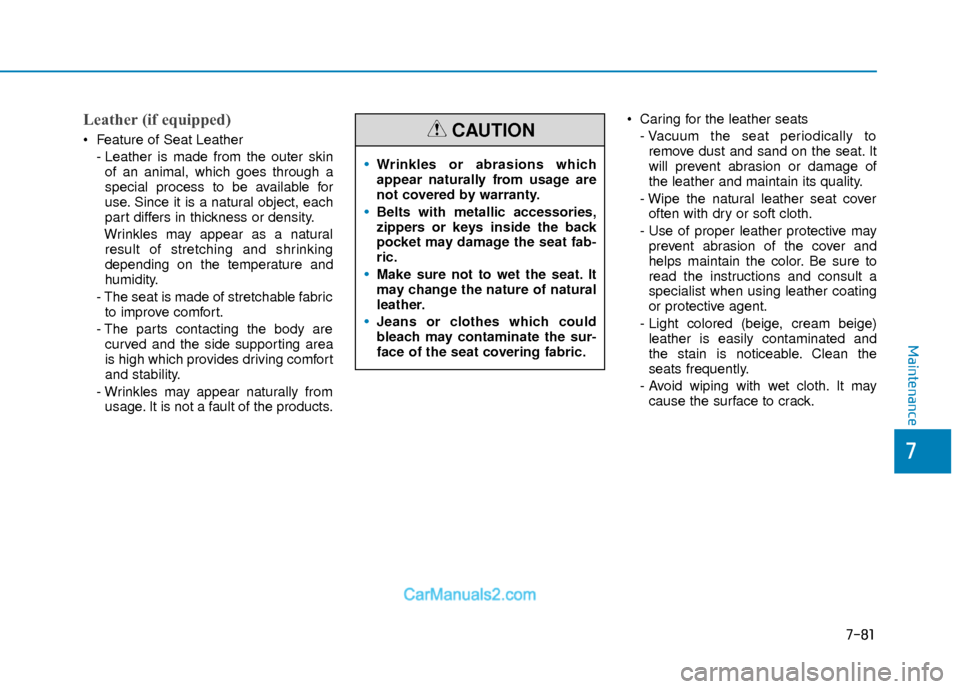
7-81
7
Maintenance
Leather (if equipped)
Feature of Seat Leather- Leather is made from the outer skinof an animal, which goes through a
special process to be available for
use. Since it is a natural object, each
part differs in thickness or density.
Wrinkles may appear as a natural result of stretching and shrinking
depending on the temperature and
humidity.
- The seat is made of stretchable fabric to improve comfort.
- The parts contacting the body are curved and the side supporting area
is high which provides driving comfort
and stability.
- Wrinkles may appear naturally from usage. It is not a fault of the products. Caring for the leather seats
- Vacuum the seat periodically toremove dust and sand on the seat. It
will prevent abrasion or damage of
the leather and maintain its quality.
- Wipe the natural leather seat cover often with dry or soft cloth.
- Use of proper leather protective may prevent abrasion of the cover and
helps maintain the color. Be sure to
read the instructions and consult a
specialist when using leather coating
or protective agent.
- Light colored (beige, cream beige) leather is easily contaminated and
the stain is noticeable. Clean the
seats frequently.
- Avoid wiping with wet cloth. It may cause the surface to crack.
Wrinkles or abrasions which
appear naturally from usage are
not covered by warranty.
Belts with metallic accessories,
zippers or keys inside the back
pocket may damage the seat fab-
ric.
Make sure not to wet the seat. It
may change the nature of natural
leather.
Jeans or clothes which could
bleach may contaminate the sur-
face of the seat covering fabric.
CAUTION
Page 500 of 526
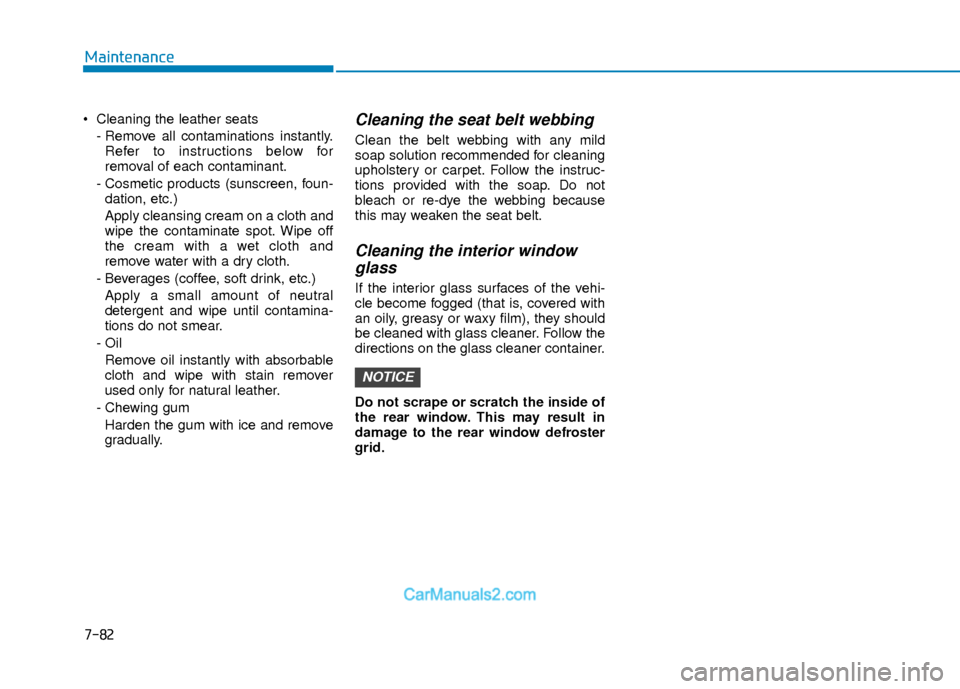
7-82
Maintenance
Cleaning the leather seats- Remove all contaminations instantly.Refer to instructions below for
removal of each contaminant.
- Cosmetic products (sunscreen, foun- dation, etc.)
Apply cleansing cream on a cloth and
wipe the contaminate spot. Wipe off
the cream with a wet cloth and
remove water with a dry cloth.
- Beverages (coffee, soft drink, etc.) Apply a small amount of neutral
detergent and wipe until contamina-
tions do not smear.
- Oil Remove oil instantly with absorbable
cloth and wipe with stain remover
used only for natural leather.
- Chewing gum Harden the gum with ice and remove
gradually.Cleaning the seat belt webbing
Clean the belt webbing with any mild
soap solution recommended for cleaning
upholstery or carpet. Follow the instruc-
tions provided with the soap. Do not
bleach or re-dye the webbing because
this may weaken the seat belt.
Cleaning the interior windowglass
If the interior glass surfaces of the vehi-
cle become fogged (that is, covered with
an oily, greasy or waxy film), they should
be cleaned with glass cleaner. Follow the
directions on the glass cleaner container.
Do not scrape or scratch the inside of
the rear window. This may result in
damage to the rear window defroster
grid.
NOTICE
Page 504 of 526
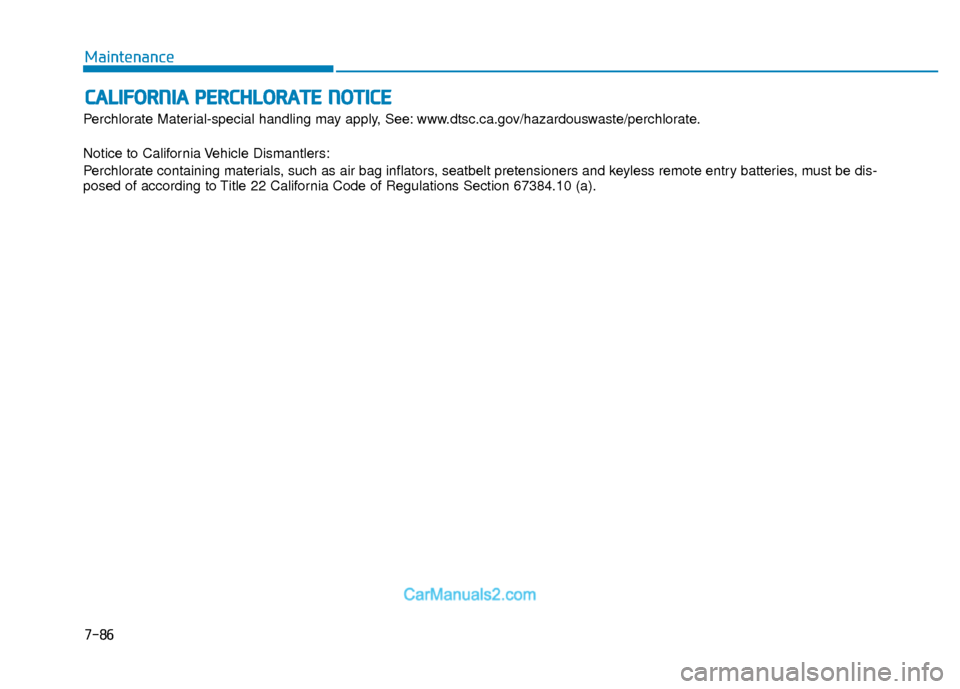
7-86
Maintenance
C
CA
A L
LI
IF
F O
O R
RN
N I
IA
A
P
P E
ER
R C
CH
H L
LO
O R
RA
A T
TE
E
N
N O
O T
TI
IC
C E
E
Perchlorate Material-special handling may apply, See: www.dtsc.ca.gov/hazardouswaste/perchlorate.
Notice to California Vehicle Dismantlers:
Perchlorate containing materials, such as air bag inflators, seatbelt pretensioners and keyless remote entry batteries, must be dis-
posed of according to Title 22 California Code of Regulations Section 67384.10 (a).
Page 516 of 526
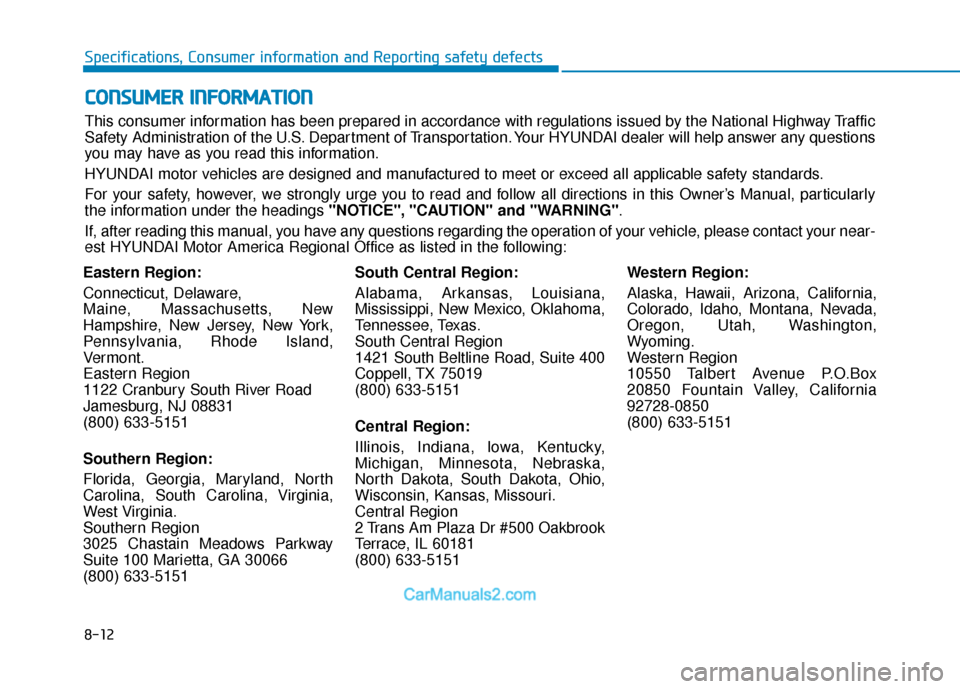
8-12
Specifications, Consumer information and Reporting safety defects
Eastern Region:
Connecticut, Delaware,
Maine, Massachusetts, New
Hampshire, New Jersey, New York,
Pennsylvania, Rhode Island,
Vermont.
Eastern Region
1122 Cranbury South River Road
Jamesburg, NJ 08831
(800) 633-5151
Southern Region:
Florida, Georgia, Maryland, North
Carolina, South Carolina, Virginia,
West Virginia.
Southern Region
3025 Chastain Meadows Parkway
Suite 100 Marietta, GA 30066
(800) 633-5151 South Central Region:
Alabama, Arkansas, Louisiana,
Mississippi, New Mexico, Oklahoma,
Tennessee, Texas.
South Central Region
1421 South Beltline Road, Suite 400
Coppell, TX 75019
(800) 633-5151
Central Region:
Illinois, Indiana, lowa, Kentucky,
Michigan, Minnesota, Nebraska,
North Dakota, South Dakota, Ohio,
Wisconsin, Kansas, Missouri.
Central Region
2 Trans Am Plaza Dr #500 Oakbrook
Terrace, IL 60181
(800) 633-5151
Western Region:
Alaska, Hawaii, Arizona, California,
Colorado, Idaho, Montana, Nevada,
Oregon, Utah, Washington,
Wyoming.
Western Region
10550 Talbert Avenue P.O.Box
20850 Fountain Valley, California
92728-0850
(800) 633-5151
C C
O
O N
NS
SU
U M
M E
ER
R
I
IN
N F
FO
O R
RM
M A
AT
TI
IO
O N
N
This consumer information has been prepared in accordance with regulations issued by the National Highway Traffic
Safety Administration of the U.S. Department of Transportation. Your HYUNDAI dealer will help answer any questions
you may have as you read this information.
HYUNDAI motor vehicles are designed and manufactured to meet or exceed all applicable safety standards.
For your safety, however, we strongly urge you to read and follow all directions in this Owner’s Manual, particularly
the information under the headings "NOTICE", "CAUTION" and "WARNING" .
If, after reading this manual, you have any questions regarding the operation of your vehicle, please contact your near-
est HYUNDAI Motor America Regional Office as listed in the following:
Page 522 of 526

I-5
If You Have a Flat Tire ...................................................6-13Checking the tire inflation pressure ...........................6-32
Components of the Tire Mobility Kit.........................6-29
Distributing the sealant ..............................................6-32
Introduction ................................................................6-27
Notes on the safe use of the Tire Mobility Kit ..........6-28
Using the Tire Mobility Kit........................................6-30
With Spare Tire ..........................................................6-13
With Tire Mobility Kit (TMK) - Type A,B ................6-19
With Tire Mobility Kit (TMK) - Type C ...................6-27
Ignition Switch..................................................................5-6 Engine Start/Stop Button ..............................................5-9
Key Ignition Switch .....................................................5-6
Important safety precautions.............................................2-2 Air Bag Hazards ...........................................................2-2
Always Wear Your Seat Belt ........................................2-2
Control Your Speed ......................................................2-2
Driver Distraction.........................................................2-2
Keep Your Vehicle in Safe Condition ..........................2-2
Restrain All Children....................................................2-2
In Case of an Emergency While Driving .........................6-2 If the Engine Stalls at a Crossroad or Crossing ...........6-2
If the Engine Stalls While Driving...............................6-2
If you Have a Flat Tire While Driving.........................6-2 Instrument Cluster...........................................................3-54
Gauges ........................................................................\
3-56
Instrument Cluster Control .........................................3-56
LCD Display Messages ..............................................3-71
Warning and Indicator lights ......................................3-61
Instrument Panel Overview ..............................................1-5
Interior Features ............................................................3-138 Clock ........................................................................\
3-141
Clothes Hanger .........................................................3-141
Cup Holder ...............................................................3-138
Floor Mat Anchor(s) .................................................3-142
Luggage Net Holder .................................................3-142
Power Outlet.............................................................3-139
Sunvisor ....................................................................3-13\
9
USB Charger ............................................................3-140
Interior Overview..............................................................1-4
Jump Starting ....................................................................6-3
I
Index
J
Page 524 of 526
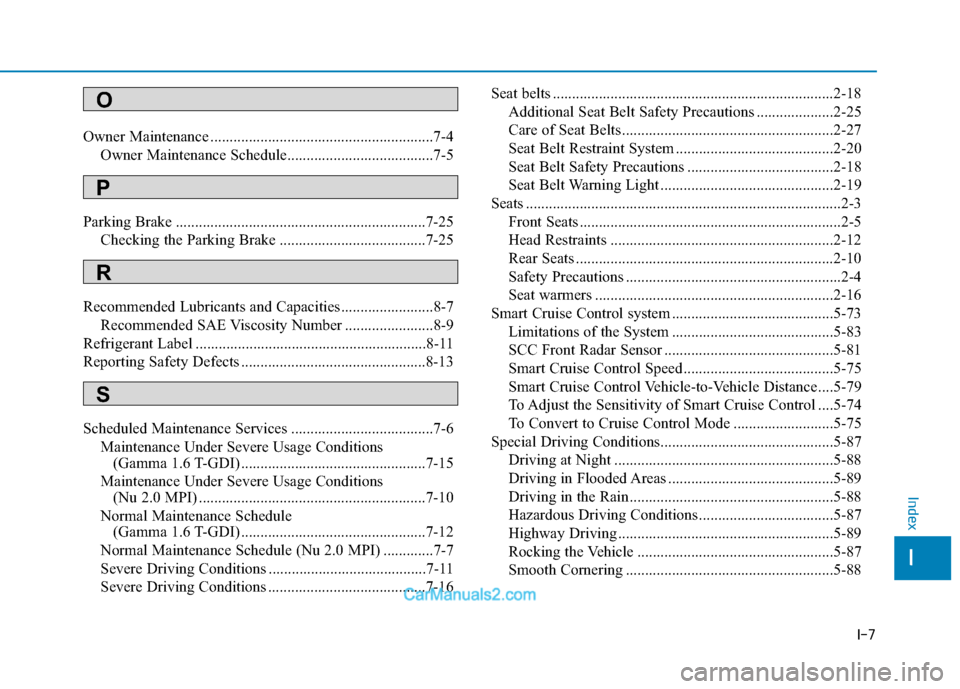
I-7
Owner Maintenance ..........................................................7-4Owner Maintenance Schedule......................................7-5
Parking Brake .................................................................7-25 Checking the Parking Brake ......................................7-25
Recommended Lubricants and Capacities ........................8-7 Recommended SAE Viscosity Number .......................8-9
Refrigerant Label ............................................................8-11
Reporting Safety Defects ................................................8-13
Scheduled Maintenance Services .....................................7-6 Maintenance Under Severe Usage Conditions (Gamma 1.6 T-GDI) ................................................7-15
Maintenance Under Severe Usage Conditions (Nu 2.0 MPI) ...........................................................7-10
Normal Maintenance Schedule (Gamma 1.6 T-GDI) ................................................7-12
Normal Maintenance Schedule (Nu 2.0 MPI) .............7-7
Severe Driving Conditions .........................................7-11
Severe Driving Conditions .........................................7-16 Seat belts ........................................................................\
.2-18
Additional Seat Belt Safety Precautions ....................2-25
Care of Seat Belts .......................................................2-27
Seat Belt Restraint System .........................................2-20
Seat Belt Safety Precautions ......................................2-18
Seat Belt Warning Light .............................................2-19
Seats ........................................................................\
..........2-3 Front Seats ....................................................................2-5
Head Restraints ..........................................................2-12
Rear Seats ...................................................................2-10
Safety Precautions ........................................................2-4
Seat warmers ..............................................................2-16
Smart Cruise Control system ..........................................5-73 Limitations of the System ..........................................5-83
SCC Front Radar Sensor ............................................5-81
Smart Cruise Control Speed .......................................5-75
Smart Cruise Control Vehicle-to-Vehicle Distance ....5-79
To Adjust the Sensitivity of Smart Cruise Control ....5-74
To Convert to Cruise Control Mode ..........................5-75
Special Driving Conditions.............................................5-87 Driving at Night .........................................................5-88
Driving in Flooded Areas ...........................................5-89
Driving in the Rain .....................................................5-88
Hazardous Driving Conditions ...................................5-87
Highway Driving ........................................................5-89
Rocking the Vehicle ...................................................5-87
Smooth Cornering ......................................................5-88
I
Index
O
P
R
S